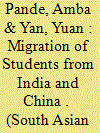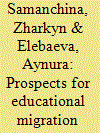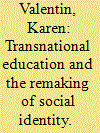| Srl | Item |
| 1 |
ID:
138415


|
|
|
|
|
| Summary/Abstract |
Recent years have seen the emergence of an international market for higher education. It is likely that the number of international students worldwide may have reached 5.2 million in 2014, with these students responsible for expenditures for tuition, accommodation, and other living expenses of no less than $50 billion. Since 1970, the number of international students is estimated to have doubled every fifteen years, on average, and the pace may be accelerating because of the expanding pool of tertiary education graduates in emerging economies where more education suppliers are entering the market. Experts predict that there will be at least 8 million international students by market. 2025, a larger group than the total population of Switzerland, Norway, or Ireland. This article traces the growth of student migration to the Cold War period when it was driven largely by the competition between the Soviet bloc and the West for influence in the developing world, how it has since been transformed (and now is being driven mainly by competition for dominance in technological innovation and trade), and concludes with questions on what it means for the less-developed countries of origin.
|
|
|
|
|
|
|
|
|
|
|
|
|
|
|
|
| 2 |
ID:
160268


|
|
|
|
|
| Summary/Abstract |
India and China send out the largest number of students for education abroad. To amplify the point, between the years 2000 and 2014, the number of students going out from China increased about twelve times, while it increased about four times from India. This outflow has become a major source of brain and capital drain for both countries. Although, both Push and Pull factors contribute to this massive exodus, each country has adopted separate strategies to address this issue. China opened up its education sector and as a result is gradually emerging as a major hub for education; India on the other hand adopted a rather inward looking approach for a long time and is still grappling with some basic issues in its education sector. Consequently, it is yet to make its education sector competitive and attract foreign students in large numbers despite having some inherent advantages.
|
|
|
|
|
|
|
|
|
|
|
|
|
|
|
|
| 3 |
ID:
139289


|
|
|
|
|
| Summary/Abstract |
As globalization of the world economy increases, the scope of intellectual migration continues to spread. One of its forms is student or educational migration—a phenomenon that largely dates to the end of the 20th century and has not been sufficiently studied so far. As for Kyrgyzstan, this is essentially the first time intellectual and student migration has been studied.
Any migration, including intellectual, undermines a country’s national potential. It should also be kept in mind that the host countries use migrants to achieve specific ideological and political goals.
|
|
|
|
|
|
|
|
|
|
|
|
|
|
|
|
| 4 |
ID:
137926


|
|
|
|
|
| Summary/Abstract |
There is no significant history of migration from Nepal to Denmark, but the post-conflict situation in Nepal and the expansion of an international, commercialised education market have resulted in a significant number of Nepalese students in Denmark. This article argues, first, that the current forms of student migration from Nepal must be examined within the context of broader class-based mobility practices and the consolidation of a relatively new middle-class in Nepal. Second, it examines the significance of education and educated status for people’s claims to belong to the middle-class in a transnational context where social status is at stake.
|
|
|
|
|
|
|
|
|
|
|
|
|
|
|
|